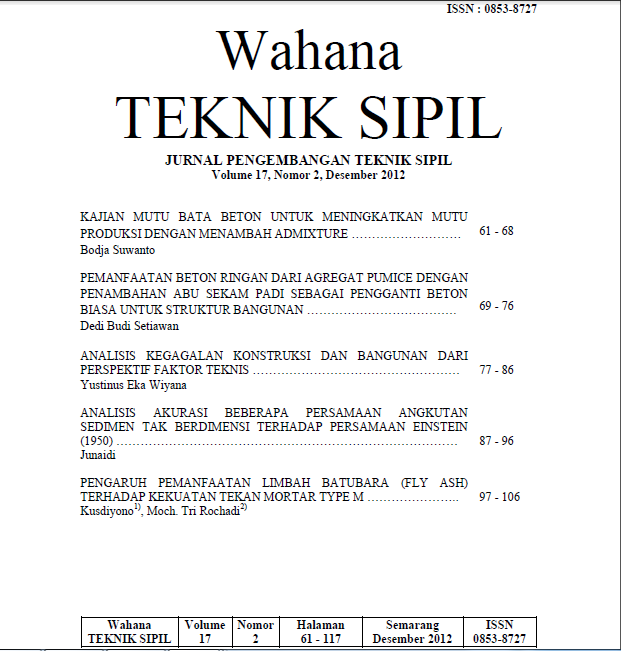Analisis Akurasi Beberapa Persamaan Angkutan Sedimen Tak Berdimensi Terhadap Persamaan Einstein (1950)
DOI:
https://doi.org/10.32497/wahanats.v17i2.118Keywords:
persamaan angkutan sedimen tak berdimensi, discrepancy ratio, line of perfect agreement, goodness of fitAbstract
Bottom of the river is always composed of a mixture of sediment in non uniform and the grain size distribution in the phase of the transported sediment is generally smoother than the distribution of basic material due to selective transport. This makes estimates of sediment transport in natural rivers is difficult; although it has provided the basic sediment transport equations are quite a lot, there is still controversy regarding its performance. This paper analyzes the accuracy of the count of the basic sediment transport using a dimensionless transport equations of Julien (2002), Brown (1950), Parker (1979), Engelund et Fredsoe (1976), Graf & Suszka (1987), Meyer-Peter & Mueller (1948), and Recking (2006) compared to Einstein (1950) formula. Methods discrepancy ratio (r) is used to demonstrate the suitability of the good (goodness of fit) between the results calculated for comparison. Based on the spread of the data on the graph of a diagonal line (line of perfect agreement) and on the basis of the percentage of data in the range of discrepancy ratio values are given, a matter of sediment transport parameters using the equations of Graf & Suszka give the most close to the matter of using the Einstein equation, compared with six other counts equation.
Downloads
Published
Issue
Section
License
Authors who publish with this journal agree to the following terms:Authors retain copyright and grant the journal right of first publication with the work simultaneously licensed under a Creative Commons Attribution License that allows others to share the work with an acknowledgement of the work's authorship and initial publication in this journal.
Authors are able to enter into separate, additional contractual arrangements for the non-exclusive distribution of the journal's published version of the work (e.g., post it to an institutional repository or publish it in a book), with an acknowledgement of its initial publication in this journal.
Authors are permitted and encouraged to post their work online (e.g., in institutional repositories or on their website) prior to and during the submission process, as it can lead to productive exchanges, as well as earlier and greater citation of published work (See The Effect of Open Access).






